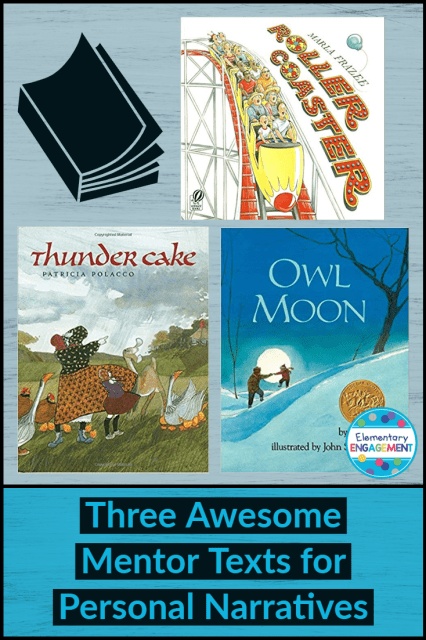For most of my 27 years of teaching, I have taught personal narratives in some way, shape or form. In doing so, I have encountered a wide variety of personal narratives to use as mentor texts. In the past, I’ve tried reading a different narrative to my students every day. I’ve tried sticking with one core personal narrative mentor text. I’ve also tried just about everything in between. The texts I use have definitely changed over the years. This year, I have stuck with three quality mentor texts that seem to cover just about everything I need them to cover. Today, I’m going to share these fabulous texts and explain how I use each one.
Why use mentor texts?
I have found no better way to explain a concept or a craft move than modeling it with a mentor text. Whether it’s starting with a bold beginning, incorporating dialogue, or using sensory details, mentor texts are my go to teaching method. When young writers are able to see and study craft moves in action from a “real author”, it helps them to mimic the moves in their own writing.
Prior to using the book during workshop time, I like to read the book purely for enjoyment during our read aloud time. I like it when my students go into the lesson with an understanding and appreciation for the story itself. During writing workshop, we go back to the text, sometimes rereading the entire book, and other times selecting specific parts. The point is to engage the students in a discussion about how the author applies various techniques to their writing.
Without any further delay, here are my three favorite mentor texts for teaching personal narratives.
I don’t think there is a better book for teaching personal narratives. This book has it all, from a strong introduction, to going step by step, incorporating dialogue and including an ending that circles back to the beginning.
In this book, Patricia Polacco tells the story about when she was a child and afraid of thunderstorms. In fact, she was so afraid in that she hid under the bed when a storm was coming. Patricia’s wise grandmother (her babushka) found a unique way to help Patricia overcome her fear. Step by step, she tells the story of how her babushka taught her how to make thundercake. After gathering all of the ingredients (which created some additional challenges), they made the cake. Babushka’s comforting words and ability to provide a sense of safety and bravery helped Patricia to overcome her fear of thunderstorms.
One of the biggest challenges to writing a personal narrative can be finding that small moment. Students tend to want to write about a whole vacation or “all about” something they love. Roller Coaster is an excellent book for modeling small moments. The entire book is about a young girl’s first roller coaster ride. This book also does an excellent job of incorporating sound words and feelings (showing, not just telling).
The book starts with the girl waiting in line to get on the roller coaster. She is nervous, but she rides it anyway. The book goes on to tell about all the twists and turns of the ride. In the end, the girl loves the ride, and she is ready to get right back on the roller coaster.
This book is another great example of an author taking her readers step by step through a small moment. One of my favorite things about this book is the language. The book utilizes a variety of descriptive strategies including adjectives and similes. Not all of my second graders are ready to dabble in the type of language used here, but the ones who are can become very inspired.
Jane Yolen tells the story about a night when she went looking for owls with her father. She talks about the cold, still night and builds the readers’ anticipation as they listen carefully for owls. Once they spot one, she forgets about the cold because she is feeling warm inside.
It’s worth mentioning that I also model the writing process and craft moves using my own personal narrative. I show my students how I use the mentor texts to make improvements in my own writing. I also use student examples (past and present) that exemplify the skills and strategies I am teaching. I use all of these resources in whole group teaching, small groups, and one-on-one conferences (just not all at once).
I’d love to know what your favorite mentor texts are for personal narratives. Please leave them in the comment section below.
Thank you!















